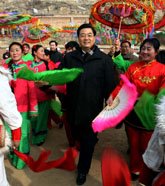
Lunar New Year in CHINA:
Somebody knows who is the Foreing Minister
of The People´s Republic of CHINA.
Wen on lunar New Year visit to Shandong
Chinese President Hu Jintao dances with residents at Hougoumen Village
in Ansai County of Yan'an City, northwest China's Shaanxi Province, on Jan. 28, 2006. [Xinhua Photo] El concepto "armonía social" fue el eje del tradicional discurso pronunciado por el primer ministro del país, Wen Jiabao, con motivo del Año Nuevo Lunar.
El concepto "armonía social" fue el eje del tradicional discurso pronunciado por el primer ministro del país, Wen Jiabao, con motivo del Año Nuevo Lunar.
"Reforzaremos la construcción económica, política y cultural, así como el desarrollo de una sociedad armoniosa para lograr un buen principio del 11 Plan Quinquenal (2006-2010)", manifestó Wen en una ceremonia en el Gran Palacio del Pueblo (sede del Legislativo).
"El horóscopo chino no predice hechos, sólo nos desvela las tendencias y fuerzas que operan, pero el esfuerzo humano y la habilidad para manejar el destino es tarea personal y social", declara Wang. El peligro de epidemias y enfermedades no aparece como una de las amenazas de este año, pero que sí estará marcado por conflictos violentos creados por los hombres, por lo que se impone una diplomacia pero basada en la imparcialidad y la justicia, y no en imposiciones o engaños.
En el plano personal, la influencia del perro tiene aspectos positivos y negativos, y en este año exigente los esfuerzos aislados no darán fruto y no podrán evitarse los conflictos, sobre todo en las relaciones interpersonales. Será un año duro, sin lugar para las falsedades y los preciosismos, un periodo para retornar a las raíces, a los principios.
In 2003, 77,715 students from 175 countries were studying in China.
Comparing with 2002, the number of the students reduced 9.45 percent.
They are distributed in 353 universities and other institutes in China's 31 provinces, autonomous regions and municipalities (excluding those in Taiwan Province, Hong Kong and Macao Special Administrative Region).
According to statistics of the students in disciplines
Liberal Art, 59,059 students (including 53,126 studying Chinese, 918 majoring in art), accounting for 75.99 percent of total overseas students;
Medicine, 7,148 students (including 3,001 in western medicine and 4,183 in traditional Chinese medicine), taking up 9.2percent of the total;
Economics, 3,091 students, taking up 3.97 percent;
Engineering, 2,693 students, taking up 3.46 percent;
History, 482 students, 0.62 percent;
Law science, 2,053 students, 2.64 percent;
Management, 1,547 students, 1.99 percent;
Education, 725 students (including 467 in sports), 0.93 percent;
Science, 465 students, 0.60 percent;
Agriculture, 241 students, 0.31 percent;
Philosophy, 175 students, 0.26 percent.
According to statistics of the students from different continents
Asia, 63,672 students, accounting for 81.93 percent;
Europe, 6,462 students, 8.31 percent;
America, 4,703 students, 6.05 percent;
Africa, 1,793 students, 2.31 percent;
Oceania, 1,085 students, 1.40 percent.
There were 25 countries whose students in China exceeded 200 each:
South Korea (ROK), 35,353;
Japan, 12,765;
the United States, 3,693;
Vietnam, 3,487;
Indonesia 2,563;
Thailand, 1,554;
Germany, 1,280;
Russia, 1,224;
Nepal, 1,199;
Mongolia, 1,060;
France, 962;
Australia, 918;
Malaysia, 841;
Britain, 657;
DPRK, 638;
the Philippines, 602;
Pakistan, 598;
Canada, 557;
Singapore, 551;
Laos, 403;
Yemen, 284;
Italy, 270;
Myanmar, 232;
Sweden, 229;
Kazakhstan, 215.
Ningún número significativo de ciudadan@s del Reino de España ( vasc@s, catalan@s, galleg@s, etc…..).
Where are studing the childs of Spanish Maoistas.....seguramente en USA.
La Republica Popular China esa potencia Mundial desconocida
una cultura milenaria que nos puede enseñar mucho, si nos dejamos.
Bueno la preguntas del Millón:
Quién de estos es el Primer Ministro:


Para más información in english. Son la alegria de la vida. 











No hay comentarios:
Publicar un comentario